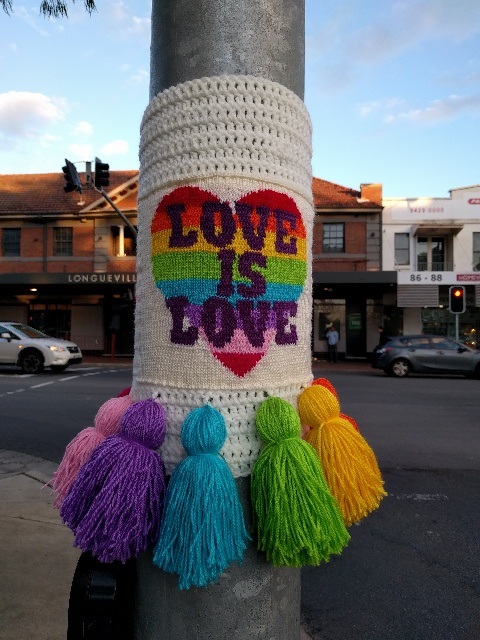Here in Australia, we’ve very recently and belatedly come to acknowledge that Love is Love, granting the same legal right to marry to same sex couples as has been afforded to heterosexual couples for centuries.
Following in the footsteps of the previous Labor Government, the sitting conservative (so-called Liberal) Government refused to vote on an issue the Australian people had been clearly ready to settle for some time. Multiple polls conducted across the nation beforehand consistently showed that over 66% of the Australian people were in favour of marriage equality.
Despite this, fearing the wrath and loss of support of conservatives, and possibly gambling on the fact that must postal surveys seldom net a return rate much over 20%, and could therefore later be said to not be representative, the sitting Government opted to consult the Australian people by way of a non-compulsory and non-binding postal survey. The survey asked the question: “Should the law be changed to allow same-sex couples to marry?”
During the farce that was the $84million cost to tax payers, and an 18 month campaign, the for and against camps rallied.
Conservatives spruiked their views about what they referred to as “gay marriage” and the so-called “gay agenda”. The no side, made use of fear- mongering outlandish claims: religious freedom was endangered; freedom of speech was under threat; parents would lose their rights. In addition, they argued (wrongly) that equality already existed under the law; and, for good measure, they claimed that the yes side was rich (!). They went on ad nauseam about the Bible, what God supposedly wants and thinks, sinners, and the evils that will befall society if gay couples were to be allowed to marry. Repeatedly, they claimed that allowing same sex couples to marry would undermine marriage for non-same sex couples.

Photo by Mélanie Villeneuve on Unsplash
On the pro side, the arguments revolved largely around the human right to be treated as equals and to be accorded the same recognition in the eyes of the law as heterosexual couples claim. Apart from the human right aspect and legal consequences in terms of medical decisions and superannuation, the pro side reminded the public: love is love.
Prior to the final date for submission of the survey, I was very moved to hear numerous heterosexual people tell me about the many conversations they were initiating with family members, with their children, with neighbours. I was moved to hear how brave many of these heterosexual allies were as they made it their business to add their support in favour of marriage equality, bringing their activism to their personal lives and networks of relationships, both in person and on social media.
The Australian Parliament already had the power to legalize same-sex marriage without a constitutional amendment. In backing away from deciding the issue in Parliament where it should have been decided, the sitting conservative Government unwittingly pushed the Australian people to get involved and to have widespread real dialogue about this issue. Instead of leaving it up to the politicians, ordinary people everywhere took steps to take a stand on marriage equality. The Australian Electoral Commission announced there was a dramatic increase in new enrolments – nearly a hundred thousand, before the roll closed. Most were thought to be young voters, the most likely to vote Yes.
Across the nation, people thought through and discussed where they stood on the issue and most importantly, WHY they were taking the position they were. Instead of ignoring the issue unless directly affected by it, people made it their business to think about marriage equality and acted on their civic responsibility to exercise their democratic right to speak . In the end, 79.5% of people returned their postal survey. In research circles, this is unheard of. It left the sitting Government in no doubt about where the vast majority of Australians stood: Australians overwhelmingly supported marriage equality. 61.6% of Australians voted in favour. Shortly after the survey results were collated, the Government moved to change the law on 9 December 2017. the bill was signed into law, redefining marriage as the “union of two people.”

Photo by Stella de Smit on Unsplash
This weekend, I attended a same sex marriage in Mudgee, wine-growing country in Western New South Wales. One of my closest friends, whom I count as a brother in my family of choice, married his partner of 16 years. A small group of friends and chosen family gathered to witness the two men openly formalise what had been a solid long-standing choice for them both. Standing in the soft afternoon light of an autumn day, overlooking rows of vines in front of a rustic shed, I listened intently to the words my friends chose to say to commit to one another.
After voicing the legally required words about choosing Terrence to be his lawful wedded husband, Nev made his vows. “I love you. I will strive to be the best person I can be. I commit to placing you ahead of others in my life, to support you and be by your side. I commit to repairing any difficulties we may experience between us and be with you as your lover, friend, and husband.”
I was deeply moved by Nev’s choice of words. Here was a promise that rang true to life as I know it. No flowery, idealised professions of undying love here. Instead, these words spoke to me of a dynamic choice – one consciously held in mind and made daily, not just once — grounded in a real relationship. The carefully chosen words spoke to a choice that’s arisen out of a recognition of what it’s really like to be in a relationship with one person, day in, day out, through the trials of life, and its many unglamorous moments. A choice made in the context of the challenging multi-layered complexity of modern life and its competing demands. This was a choice I could believe in. A choice Terrence and Nev can both count on. To me, those words came out of both men having already experienced the challenges of life partnership and what it takes to make it work.
The words made me think of the way a sword is annealed and quenched, the process whereby metal is repeatedly pounded flat and folded over on itself on an anvil, before being plunged into and out of fire followed by ice water. Only if the sword withstands this process many times over does it stand a chance to have the qualities of strength, durability as well as flexibility necessary for it to become a worthy sword.

Photo by Tanja Heffner on Unsplash
So it is, perhaps, of life partnership. Unlike what I see in wedding magazine shots and hear about from couples planning weddings, it’s not about pretty flowers, extravagant outfits, hired vintage cars, fairy-tale settings, personalised place markers, flowery poems and overblown promises.
Life partnership is more like sword-smithing. Aspiring partners need to be willing to continually strive to be the best they can be, to expect and acknowledge when they fall short of that mark, and be willing to make whatever repairs will be needed to rebuild trust, to strengthen bonds when life and poor choices weaken them.
Then, and only then, can a couple really count on the vows they made to be more than long-forgotten words carefully crafted for effect in one moment. Then, and only then, can life partners draw on the power of their vows to guide and hold them through the inevitable hardships that will unfold over time, helping to keep their bond strong even in the broken places.
If you’re in a committed relationship – whether married or not- currently undergoing some challenges, or are considering matrimony, and trying to enter into your commitment consciously, you might consider the following questions-
- Are you prepared to strive to be the best person you can be – not just for your own sake but for your partner’s sake? What would striving to be your ‘best self’ entail?
- What gets in the way or would get in the way of you keeping to your commitment to be your best self? What measures are you prepared to take to address these risks?
- Are you prepared to put your partner ahead of others? What does this require you to do in relation to your work, your other family and friends?
- Are you prepared to support your partner and stand by their side? Are you prepared to be challenged by your partner and to challenge them at times, in the interest of keeping the integrity of your bond strong?
- Are you prepared to be open and honest with your partner, so that you each know you will always be the first to know about matters you need to know about?
- Are you prepared to be influenced by your partner in everyday life?
- Are you willing to share as true equals in decisions so that choices made benefit both of you?
- When the wheels fall off, as they inevitably do and will, are you prepared to repair quickly and to accept repair moves by your partner? What gets in the way of you making effective repairs, and what are you willing to do about it?
If you can see you need to skill up in some or many of the areas above, call me and let’s arrange a time for me to meet with you both. Let’s see what we can do to make you both the kind of people you want to be. The kind of people you’d want to make a life commitment to.


